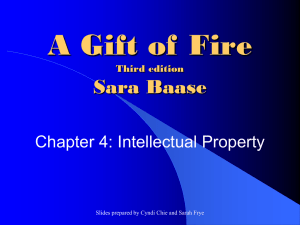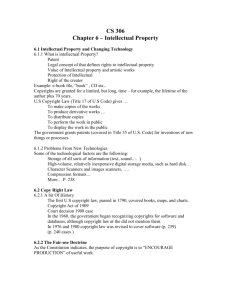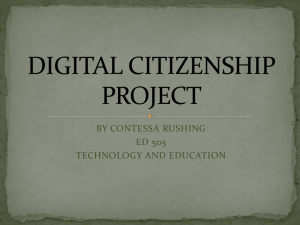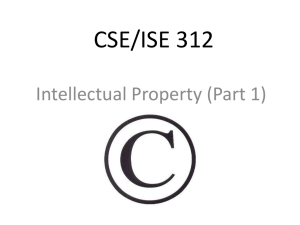A Gift of Fire Sara Baase Chapter 4: Intellectual Property Third edition
advertisement
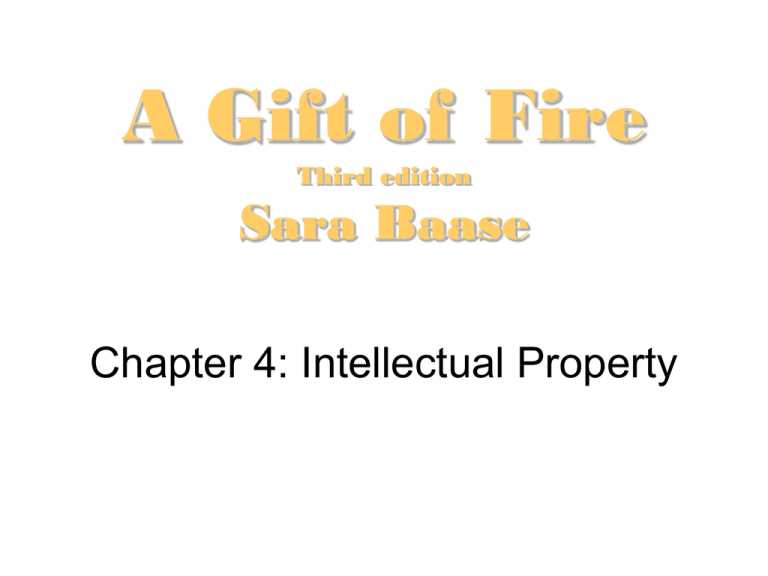
A Gift of Fire Third edition Sara Baase Chapter 4: Intellectual Property What We Will Cover • Intellectual Property and Changing Technology • Copyright Law and Significant Cases • Copying and Sharing • Search Engines and Online Libraries • Free-Speech Issues • Free Software • Issues for Software Developers Intellectual Property and Changing Technology What is Intellectual Property? • The intangible creative work, not its particular physical form • Value of intelligence and artistic work comes from creativity, ideas, research, skills, labor, non-material efforts and attributes the creator provides • Protected by copyright and patent law Intellectual Property and Changing Technology (cont.) What is Intellectual Property? (cont.) • Copyright holders have exclusive rights: – To make copies – To produce derivative works, such as translations into other languages or movies based on books – To distribute copies – To perform the work in public (e.g. music, plays) – To display the work in public (e.g. artwork, movies, computer games, video on a Web site) Intellectual Property and Changing Technology (cont.) Challenges of New Technology: • Digital technology and the internet has made copyright infringement easier and cheaper • New compression technologies have made copying large files (e.g. graphics, video and audio files) feasible • New tools allow us to modify graphics, video and audio files to make derivative works • Scanners allow us to change the media of a copyrighted work, converting printed text, photos, and artwork to electronic form Intellectual Property and Changing Technology Discussion Questions • How is intellectual property like physical property? • How is intellectual property different than physical property? • Do you agree with the idea that someone can "own" intellectual property? Copyright Law and Significant Cases A bit of history: • 1790 first copyright law passed • 1909 Copyright Act of 1909 defined an unauthorized copy as a form that could be seen and read visually • 1976 and 1980 copyright law revised to include software and databases that exhibit "authorship" (original expression of ideas), included the "Fair Use Doctrine" • 1982 high-volume copying became a felony • 1992 making multiple copies for commercial advantage and private gain became a felony Copyright Law and Significant Cases (cont.) A bit of History (cont.): • 1997 No Electronic Theft Act made it a felony to willfully infringe copyright by reproducing or distributing one or more copies of copyrighted work with a total value of more than $1,000 within a sixmonth period • 1998 Digital Millennium Copyright Act (DMCA) prohibits making, distributing or using tools to circumvent technological copyright protection systems and included protection from some copyright lawsuits for Web sites where users post material • 2005 Congress made it a felony to record a movie in a movie theater Copyright Law and Significant Cases (cont.) Fair Use Doctrine: • Four factors considered – Purpose and nature of use – commercial (less likely) or non-profit purposes – Nature of the copyrighted work – Amount of significance or portion used – Effect of use on potential market or value of the copyright work (will it reduce sales of work?) • No single factor alone determines • Not all factors given equal weight, varies by circumstance Copyright Law and Significant Cases (cont.) Significant Cases: • Sony v. Universal City Studios (1984) – Supreme Court decided that the makers of a device with legitimate uses should not be penalized because some people may use it to infringe on copyright – Supreme Court decided copying movies for later viewing was fair use – Arguments against fair use • People copied the entire work • Movies are creative, not factual Copyright Law and Significant Cases (cont.) Significant Cases (cont.): • Sony v. Universal City Studios (1984) (cont.) – Arguments for fair use • The copy was for private, noncommercial use and generally was not kept after viewing • The movie studios could not demonstrate that they suffered any harm • The studios had received a substantial fee for broadcasting movies on TV, and the fee depends on having a large audience who view for free Copyright Law and Significant Cases (cont.) Significant Cases (cont.): • Reverse engineering: game machines • Sega Enterprises Ltd. v. Accolade Inc. (1992) • Atari Games v. Nintendo (1992) • Sony Computer Entertainment, Inc. v. Connectix Corporation (2000) • Courts ruled that reverse engineering does not violate copyright if the intention is to make new creative works (video games), not copy the original work (the game systems) Copyright Law and Significant Cases (cont.) Significant Cases (cont.): • Sharing music: the Napster case • Was the sharing of music via Napster fair use? • Napster's arguments for fair use – The Sony decision allowed for entertainment use to be considered fair use – Did not hurt industry sales because users sampled the music on Napster and bought the CD if they liked it Copyright Law and Significant Cases (cont.) Significant Cases (cont.): • Sharing music: the Napster case (cont.) • RIAA's (Recording Industry Association of America) arguments against fair use – "Personal" meant very limited use, not trading with thousands of strangers – Songs and music are creative works and users were copying whole songs – Claimed Napster severely hurt sales • Court ruled sharing music via copied MP3 files violated copyright Copyright Law and Significant Cases (cont.) Significant Cases (cont.): • Sharing music: the Napster case (cont.) • Was Napster responsible for the actions of its users? • Napster's arguments – It was the same as a search engine, which is protected under the DMCA – They did not store any of the MP3 files – Their technology had substantial legitimate uses Copyright Law and Significant Cases (cont.) Significant Cases (cont.): • Sharing music: the Napster case (cont.) • RIAA's arguments – Companies are required to make an effort to prevent copyright violations and Napster did not take sufficient steps – Napster was not a device or new technology and the RIAA was not seeking to ban the technology • Court ruled Napster liable because they had the right and ability to supervise the system, including copyright infringing activities Copyright Law and Significant Cases (cont.) Significant Cases (cont.): • File sharing: MGM v. Grokster • Grokster, Gnutella, Morpheus, Kazaa, and others provided peer-to-peer (P2P) file sharing services – The companies did not provide a central service or lists of songs – P2P file transfer programs have legitimate uses • Lower Courts ruled that P2P does have legitimate uses • Supreme Court ruled that intellectual property owners could sue the companies for encouraging copyright infringement Copyright Law and Significant Cases Discussion Question • What do you think the impact would be on creative industries, such as music, movies and fiction novels, if copyright laws did not protect their intellectual property? Copying and Sharing Responses from the Content Industries: • Ideas from the software industries – Expiration dates within the software – Dongles (a device that must be plugged into a computer port) – Copy protection that prevents copying – Activation or registration codes – Obtained court orders to shut down Internet bulletin boards and Web sites Copying and Sharing (cont.) Responses from the Content Industries (cont.): • Banning, suing and taxing – Ban or delay technology via lawsuits • CD-recording devices • Digital Audio Tapes (DAT) • DVD players • Portable MP3 players – Require that new technology include copyright protections – Tax digital media to compensate the industry for expected losses Copying and Sharing (cont.) Digital Rights Management : • Collection of techniques that control uses of intellectual property in digital formats • Includes hardware and software schemes using encryption • The producer of a file has flexibility to specify what a user may do with it • Apple, Microsoft and Sony all use different schemes of DRM Copying and Sharing (cont.) The DMCA vs. Fair Use, Freedom of Speech, and Innovation: • Lawsuits have been filed to ban new technologies • U.S. courts have banned technologies such as DeCSS even though it has legitimate uses, while courts in other countries have not. • Protesters published the code as part of creative works (in haiku, songs, short movies, a computer game and art) • U.S. courts eventually allowed publishing of DeCSS, but prohibited manufacturers of DVD players from including it in their products Copying and Sharing (cont.) Video Sharing: Conflict and Solutions: • Industry issues "take down" notices per the DMCA • As long as sites like YouTube and MySpace comply with take down notices they are not in violation • Take down notices may violate fair use, some have been issued against small portions of video being used for educational purposes Copying and Sharing (cont.) New Business Models and Constructive Solutions: • Organizations set up to collect and distribute royalty fees (e.g. the Copyright Clearance Center), users don't have to search out individual copyright holders • Sites such as iTunes and the new Napster provide legal means for obtaining inexpensive music and generate revenue for the industry and artists • Revenue sharing allows content-sharing sites to allow the posting of content and share their ad revenues with content owners in compensation Copying and Sharing (cont.) New Business Models and Constructive Solutions (cont.): • The industry imbeds advertising in files that it then posts to the P2P sites, the advertiser gets its message out and the industry gets its fees • Fan fiction is generally not seen as a threat, the writers are also the customers for the original works Copying and Sharing (cont.) Ethical Arguments About Copying: • Unlike physical property, copying or distributing a song, video, or computer program does not decrease the use or enjoyment by another person • Copying can decrease the economic value of creative work produced for sale • The fair use guidelines are useful ethical guidelines • There are many arguments for and against unauthorized copying Copying and Sharing (cont.) International Piracy: • Some countries do not recognize or protect intellectual property • Countries that have high piracy rates often do not have a significant software industry • Many countries that have a high amount of piracy are exporting the pirated copies to countries with strict copyright laws • Economic sanctions often penalize legitimate businesses, not those they seek to target Copying and Sharing Discussion Question • Some have argued that copyright lawsuits have been used to stifle innovation, do you agree? Why or why not? Search Engines and Online Libraries • Search Engines – Caching and displaying small excerpts is fair use – Creating and displaying thumbnail images is fair use – Court ordered Google to remove links to pages that infringe copyright; Google is appealing Search Engines and Online Libraries • Books Online – Project Guttenberg digitizes books in the public domain – Microsoft scanned millions of public domain books in University of California's library – Google has scanned millions of books that are in the public domain and that are not; they display only excerpts from those still copyrighted • Some court rulings favor search engines and information access; some favor content producers Free-Speech Issues Domain Names: • Domain names may be used to criticize or protest (e.g. XYZIsJunk.org) • Companies sue under trademark violation, but most cases dismissed • Some companies buy numerous domain names containing their name so others cannot use them Free-Speech Issues Posting Documents for Criticism: • Documents that are copyrighted and trade secrets have been posted as a form of criticism • Organizations have sued to have the documents removed from the Web • In some cases courts have ruled that it is a copyright violation and the documents must be removed • In one judgment against the Church of Scientology, the court ruled that the church’s primary motivation was "to stifle criticism of Scientology in general and to harass its critics" Free Software • Free software - idea, an ethic, advocated and supported by large, loose-knit group of computer programmers who allow people to copy, use, and modify their software • Free means freedom of use, not necessarily lack of cost • Open source - software distributed or made public in source code (readable and modifiable) • Proprietary software - (commercial) sold in object code (obscure, not modifiable) (E.g.: Microsoft Office) Free Software Should All Software Be Free? • Would there be sufficient incentives to produce the huge quantity of consumer software available now? • Would the current funding methods for free software be sufficient to support all software development? • Should software be covered under copyright law? • Concepts such as copyleft and the GNU Public License provide alternatives to proprietary software within today's current legal framework Issues for Software Developers Patents for Software? • Patents protect inventions of new things or processes • The Supreme Court said that software could not be patented; however a machine that included software could • Patents are not supposed to be given for things that are obvious or are already in common use • The Patent Office has made mistakes Issues for Software Developers (cont.) Patents on Web Technologies: • Amazon agreed to pay IBM who holds patents for online catalogs and targeted advertising • Microsoft was fined $1.5 billion for violating MP3 patents. The decision was voided; the case continues. • Friendster applied for a patent on its socialnetworking Web techniques. While the patent was pending, sites such as MySpace sprang up. Friendster's patent was granted and it may now charge licensing fees to businesses using the technology.

